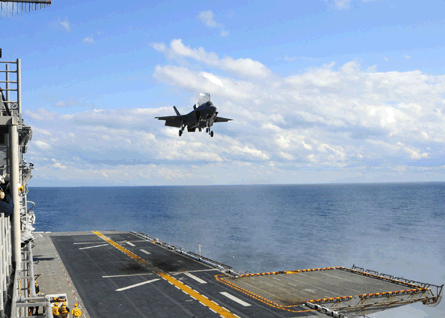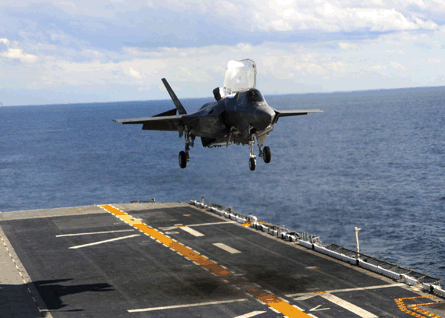With the beginning of at-sea trials for the Lockheed Martin F-35B, the short take-off and vertical landing (STOVL) variant had entered the most critical phase in a year-long campaign to overcome probation and be spared cancellation.
For the next two to six weeks, two F-35B flight test aircraft will attempt to prove the proposed successor to the McDonnell Douglas AV-8B Harrier II can operate aboard the US Marine Corps' relatively small amphibious carriers.
No signs of trouble were apparent in a video released by the US Naval Air Systems Command of aircraft BF-2's first landing on the USS Wasp on 3 October. The aircraft was landed by pilot Lt Col Fred Schenk.
 |
|---|
 |
 |
© US Navy |
But programme officials will continue to scrutinise every detail of the F-35B's performance at sea in the coming weeks.
The Marines expect to learn that at least some adaptations are necessary in the shift from the Harrier II, which has an empty weight of 6,340kg (13,977lb), to the minimum 13,600kg of the F-35B.
"There's no doubt in my mind we will learn things," said Lt Gen Terry Robling, the USMC's deputy commandant for aviation.
The programme, however, can afford few unpleasant surprises, as US budget pressures have made any programme facing cost and schedule challenges vulnerable.
As the most technically ambitious variant of the type, the F-35B has been a frequent source of the issues that have delayed the overall programme by at least five years.
In 2004, programme officials extended the development of all three variants by two years to redesign the F-35B, which was overweight by more than 1,400kg.
Last year, the F-35B faced its biggest problem yet, with flight tests slowed by five design problems in the propulsion system and durability tests halted after a bulkhead cracked.
Around the same time, the UK converted planned orders for 138 F-35Bs to the large-deck carrier-based F-35C variant.
Even the USMC scaled back its acquisition plans earlier this year, agreeing to buy 80 F-35Cs instead of some STOVL variants.
These issues left the F-35B programme on probation, with remaining commitments from the Marines to buy 340 and the Italian navy to order 62.
In February, Robert Gates - then US secretary of defense - said the F-35B could be cancelled if any new problems are discovered.
Almost as suddenly, however, the F-35B programme started to recover. Temporary fixes allowed the F-35B's propulsion system to resume STOVL-mode flight tests.
The programme has amassed about 180 vertical landings so far this year, compared with 10 in 2011.
The cracked bulkhead has been patched up and redesigned and three of the five glitches in the propulsion system are already permanently fixed.
Of the remaining two issues, one fix is scheduled to be approved in December, and the last problem should be resolved in February 2012, Robling added.
Although the F-35 was grounded for 16 days in August, the electrical system at the root of the problem is common to all three variants.
Meanwhile, programme officials also appear to have resolved a 90.7kg performance shortfall in the vertical lift bring-back weight of the F-35B in hover while returning to a ship.
Engine manufacturer Pratt & Whitney has confirmed the solution includes raising the output of the propulsion system by about 100lb-thrust (0.4kN).
Programme officials still hope for more orders, and Spain is considered a potential buyer of the F-35B.
Meanwhile, Singapore - a security co-operation participant in the F-35 joint programme office - has launched studies aimed at considering the STOVL variant, said Gregg Pyers, lift fan programme director for UK-based Rolls-Royce.
The question remains whether the F-35B's progress to date will prove enough to satisfy a new regime, as the US Department of Defense enters a period of budgetary uncertainty.
Leon Panetta, who succeeded Gates in August, has not commented directly on the F-35's future, but the signs paint a gloomy picture for the development programme.
Last month, US Air Force leaders predicted that the F-35 production ramp-up could be further tweaked when the DoD releases its next six-year spending plan in February.
Moreover, the US Senate's powerful appropriations committee voted to freeze F-35 production through 2014.
In the next few weeks, the focus for the F-35B's supporters will be simply clearing the shipboard trials.
No matter what those tests reveal, it is clear the programme's future is still anybody's guess.
Even Robling is unsure. He said: "My guess is [Panetta] will continue it - if the budget will allow it."
Source: Flight International



















